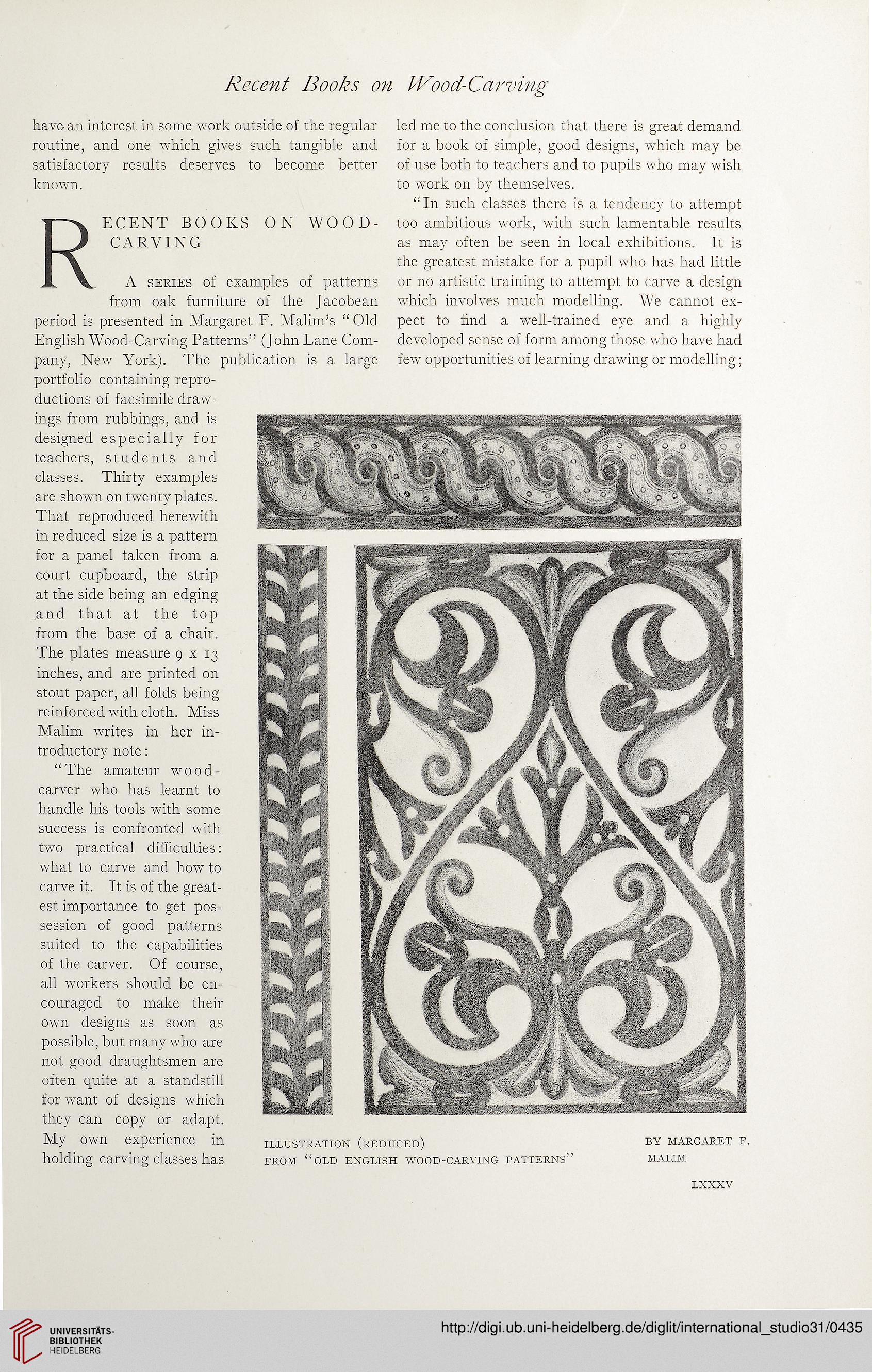Recent Books on Wood-Carving
have an interest in some work outside of the regular
routine, and one which gives such tangible and
satisfactory results deserves to become better
known.
ECENT BOOKS
CARVING
ON WOOD-
A series of examples of patterns
from oak furniture of the Jacobean
period is presented in Margaret F. Malim’s “ Old
English Wood-Carving Patterns” (John Lane Com-
pany, New York). The publication is a large
portfolio containing repro-
ductions of facsimile draw-
ings from rubbings, and is
designed especially for
teachers, students and
classes. Thirty examples
are shown on twenty plates.
That reproduced herewith
in reduced size is a pattern
for a panel taken from a
court cupboard, the strip
at the side being an edging
and that at the top
from the base of a chair.
The plates measure 9 x 13
inches, and are printed on
stout paper, all folds being
reinforced with cloth. Miss
Malim writes in her in-
troductory note:
“The amateur wood-
carver who has learnt to
handle his tools with some
success is confronted with
two practical difficulties:
what to carve and how to
carve it. It is of the great-
est importance to get pos-
session of good patterns
suited to the capabilities
of the carver. Of course,
all workers should be en-
couraged to make their
own designs as soon as
possible, but many who are
not good draughtsmen are
often quite at a standstill
for want of designs which
they can copy or adapt.
My own experience in
holding carving classes has
led me to the conclusion that there is great demand
for a book of simple, good designs, which may be
of use both to teachers and to pupils who may wish
to work on by themselves.
“In such classes there is a tendency to attempt
too ambitious work, with such lamentable results
as may often be seen in local exhibitions. It is
the greatest mistake for a pupil who has had little
or no artistic training to attempt to carve a design
which involves much modelling. We cannot ex-
pect to find a well-trained eye and a highly
developed sense of form among those who have had
few opportunities of learning drawing or modelling;
ILLUSTRATION (REDUCED)
FROM “OLD ENGLISH WOOD-CARVING PATTERNS”
BY MARGARET F.
MALIM
LXXXV
have an interest in some work outside of the regular
routine, and one which gives such tangible and
satisfactory results deserves to become better
known.
ECENT BOOKS
CARVING
ON WOOD-
A series of examples of patterns
from oak furniture of the Jacobean
period is presented in Margaret F. Malim’s “ Old
English Wood-Carving Patterns” (John Lane Com-
pany, New York). The publication is a large
portfolio containing repro-
ductions of facsimile draw-
ings from rubbings, and is
designed especially for
teachers, students and
classes. Thirty examples
are shown on twenty plates.
That reproduced herewith
in reduced size is a pattern
for a panel taken from a
court cupboard, the strip
at the side being an edging
and that at the top
from the base of a chair.
The plates measure 9 x 13
inches, and are printed on
stout paper, all folds being
reinforced with cloth. Miss
Malim writes in her in-
troductory note:
“The amateur wood-
carver who has learnt to
handle his tools with some
success is confronted with
two practical difficulties:
what to carve and how to
carve it. It is of the great-
est importance to get pos-
session of good patterns
suited to the capabilities
of the carver. Of course,
all workers should be en-
couraged to make their
own designs as soon as
possible, but many who are
not good draughtsmen are
often quite at a standstill
for want of designs which
they can copy or adapt.
My own experience in
holding carving classes has
led me to the conclusion that there is great demand
for a book of simple, good designs, which may be
of use both to teachers and to pupils who may wish
to work on by themselves.
“In such classes there is a tendency to attempt
too ambitious work, with such lamentable results
as may often be seen in local exhibitions. It is
the greatest mistake for a pupil who has had little
or no artistic training to attempt to carve a design
which involves much modelling. We cannot ex-
pect to find a well-trained eye and a highly
developed sense of form among those who have had
few opportunities of learning drawing or modelling;
ILLUSTRATION (REDUCED)
FROM “OLD ENGLISH WOOD-CARVING PATTERNS”
BY MARGARET F.
MALIM
LXXXV





